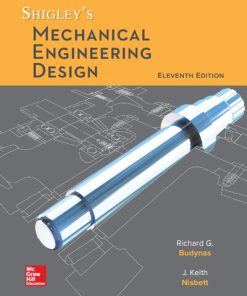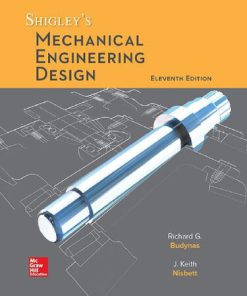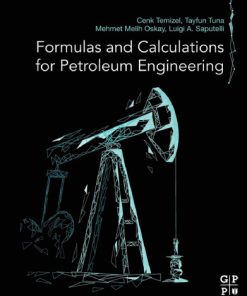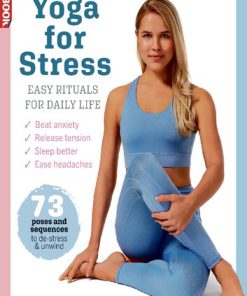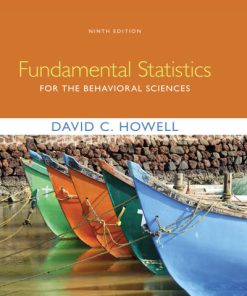Roark’s Formulas for Stress and Strain 9th Edition by Richard Budynas, Ali Sadegh 1260453758 9781260453751
$50.00 Original price was: $50.00.$25.00Current price is: $25.00.
Roark’s Formulas for Stress and Strain 9th Edition by Richard Budynas, Ali Sadegh – Ebook PDF Instant Download/Delivery: 1260453758, 9781260453751
Full download Roark’s Formulas for Stress and Strain 9th Edition after payment
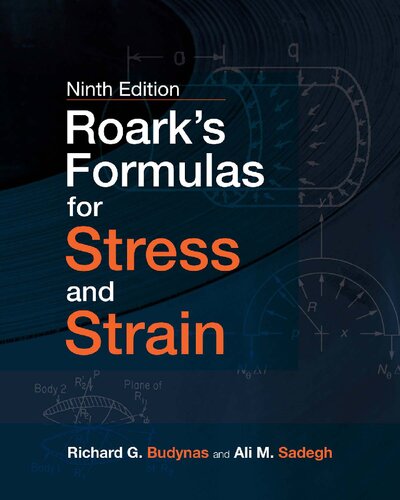
Product details:
ISBN 10: 1260453758
ISBN 13: 9781260453751
Author: Richard Budynas, Ali Sadegh
Publisher’s Note: Products purchased from Third Party sellers are not guaranteed by the publisher for quality, authenticity, or access to any online entitlements included with the product. The industry-standard resource for stress and strain formulas―fully updated for the latest advances and restructured for ease of use This newly designed and thoroughly revised guide contains accurate and thorough tabulated formulations that can be applied to the stress analysis of a comprehensive range of structural components. Roark’s Formulas for Stress and Strain, Ninth Edition has been reorganized into a user-friendly format that makes it easy to access and apply the information. The book explains all of the formulas and analyses needed by designers and engineers for mechanical system design. You will get a solid grounding in the theory behind each formula along with real-world applications that cover a wide range of materials. Coverage includes: • The behavior of bodies under stress • Analytical, numerical, and experimental methods • Tension, compression, shear, and combined stress • Beams and curved beams • Torsion, flat plates, and columns • Shells of revolution, pressure vessels, and pipes • Bodies under direct pressure and shear stress • Elastic stability • Dynamic and temperature stresses • Stress concentration • Fatigue and fracture • Stresses in fasteners and joints • Composite materials and solid biomechanics
Roark’s Formulas for Stress and Strain 9th table of contents:
CHAPTER 1 Introduction
1.1 Terminology
1.2 State Properties, Units, and Conversions
1.3 Contents
1.4 References
CHAPTER 2 Stress and Strain: Important Relationships
2.1 Stress
2.2 Strain and the Stress–Strain Relations
2.3 Stress Transformations
2.4 Strain Transformations
2.5 Mohr’s Circle
2.6 Mohr’s Circles for 3D Stress Analysis
2.7 Tables
2.8 References
CHAPTER 3 The Behavior of Bodies under Stress
3.1 Methods of Loading
3.2 Elasticity; Proportionality of Stress and Strain
3.3 Factors Affecting Elastic Properties
3.4 Load Deformation Relation for a Body
3.5 Plasticity
3.6 Creep and Rupture under Long-Time Loading
3.7 Criteria of Elastic Failure and of Rupture
3.8 Fatigue
3.9 Brittle Fracture
3.10 Stress Concentration
3.11 Effect of Form and Scale on Strength; Rupture Factor
3.12 Prestressing
3.13 Elastic Stability
3.14 Tables: Mechanical Properties of Materials
3.15 References
CHAPTER 4 Principles and Analytical Methods
4.1 Equations of Motion and of Equilibrium
4.2 Principle of Superposition
4.3 Principle of Reciprocal Deflections
4.4 Method of Consistent Deformations (Strain Compatibility)
4.5 Energy Methods
4.6 Castigliano’s Theorem
4.7 Dimensional Analysis
4.8 Remarks on the Use of Formulas
4.9 References
CHAPTER 5 Numerical Methods
5.1 The Finite Difference Method
5.2 The Finite Element Method
5.3 The Boundary Element Method
5.4 Zeroes of Polynomials
5.5 Solution of Differential Equations
5.6 Numerical Integration
5.7 References
5.8 Additional Uncited References for Finite Elements
5.9 Additional Uncited References for Boundary Elements
CHAPTER 6 Experimental Methods
6.1 Measurement Techniques
6.2 Electrical Resistance Strain Gages
6.3 Detection of Plastic Yielding
6.4 Analogies
6.5 Wheatstone Bridge
6.6 Nondestructive Testing
6.7 Tables
6.8 References
CHAPTER 7 Tension, Compression, Shear, and Combined Stress
7.1 Bar under Axial Tension (or Compression); Common Case
7.2 Bar under Tension (or Compression); Special Cases
7.3 Composite Members
7.4 Trusses
7.5 Body under Pure Shear Stress
7.6 Cases of Direct Shear Loading
7.7 Combined Stress
CHAPTER 8 Beams; Flexure of Straight Bars
8.1 Straight Beams (Common Case) Elastically Stressed
8.2 Composite Beams and Bimetallic Strips
8.3 Three-Moment Equation
8.4 Rigid Frames
8.5 Beams on Elastic Foundations
8.6 Deformation Due to the Elasticity of Fixed Supports
8.7 Beams under Simultaneous Axial and Transverse Loading
8.8 Beams of Variable Section
8.9 Slotted Beams
8.10 Beams of Relatively Great Depth
8.11 Beams of Relatively Great Width
8.12 Beams with Wide Flanges; Shear Lag
8.13 Beams with Very Thin Webs
8.14 Beams Not Loaded in Plane of Symmetry; Flexural Center
8.15 Straight Uniform Beams (Common Case); Ultimate Strength
8.16 Plastic, or Ultimate Strength, Design
8.17 Tables
8.18 References
CHAPTER 9 Curved Beams
9.1 Bending in the Plane of the Curve
9.2 Deflection of Curved Beams
9.3 Circular Rings and Arches
9.4 Elliptical Rings
9.5 Curved Beams Loaded Normal to Plane of Curvature
9.6 Tables
9.7 References
CHAPTER 10 Torsion
10.1 Straight Bars of Uniform Circular Section under Pure Torsion
10.2 Bars of Noncircular Uniform Section under Pure Torsion
10.3 Effect of End Constraint
10.4 Effect of Longitudinal Stresses
10.5 Ultimate Strength of Bars in Torsion
10.6 Torsion of Curved Bars; Helical Springs
10.7 Tables
10.8 References
CHAPTER 11 Flat Plates
11.1 Common Case
11.2 Bending of Uniform-Thickness Plates with Circular Boundaries
11.3 Circular-Plate Deflection Due to Shear
11.4 Bimetallic Plates
11.5 Nonuniform Loading of Circular Plates
11.6 Circular Plates on Elastic Foundations
11.7 Circular Plates of Variable Thickness
11.8 Disk Springs
11.9 Narrow Ring under Distributed Torque about Its Axis
11.10 Bending of Uniform-Thickness Plates with Straight Boundaries
11.11 Effect of Large Deflection; Diaphragm Stresses
11.12 Plastic Analysis of Plates
11.13 Ultimate Strength
11.14 Tables
11.15 References
CHAPTER 12 Columns and Other Compression Members
12.1 Columns; Common Case
12.2 Local Buckling
12.3 Strength of Latticed Columns
12.4 Eccentric Loading; Initial Curvature
12.5 Columns under Combined Compression and Bending
12.6 Thin Plates with Stiffeners
12.7 Short Prisms under Eccentric Loading
12.8 Table
12.9 References
CHAPTER 13 Shells of Revolution; Pressure Vessels; Pipes
13.1 Circumstances and General State of Stress
13.2 Thin Shells of Revolution under Distributed Loadings Producing Membrane Stresses Only
13.3 Thin Shells of Revolution under Concentrated or Discontinuous Loadings Producing Bending and Membrane Stresses
13.4 Thin Multielement Shells of Revolution
13.5 Thin Shells of Revolution under External Pressure
13.6 Thick Shells of Revolution
13.7 Pipe on Supports at Intervals
13.8 Tables
13.9 References
CHAPTER 14 Bodies under Direct Bearing and Shear Stress
14.1 Stress Due to Pressure between Elastic Bodies
14.2 Rivets and Riveted Joints
14.3 Miscellaneous Cases
14.4 Table
14.5 References
CHAPTER 15 Elastic Stability
15.1 General Considerations
15.2 Buckling of Bars
15.3 Buckling of Flat and Curved Plates
15.4 Buckling of Shells
15.5 Tables
15.6 References
CHAPTER 16 Dynamic and Temperature Stresses
16.1 Dynamic Loadings; General Conditions
16.2 Body in a Known State of Motion
16.3 Impact and Sudden Loading
16.4 Impact and Sudden Loading; Approximate Formulas
16.5 Remarks on Stress Due to Impact
16.6 Vibration
16.7 Temperature Stresses
16.8 Tables
16.9 References
CHAPTER 17 Stress Concentration
17.1 Static Stress and Strain Concentration Factors
17.2 Stress Concentration Reduction Methods
17.3 Tables
17.4 References
CHAPTER 18 Fatigue and Fracture
18.1 Fatigue in Materials
18.2 Fatigue Testing
18.3 Fatigue and Crack Growth
18.4 Creep
18.5 Fracture Mechanics
18.6 The Stress Intensity Factor
18.7 Fracture Toughness
18.8 Crack Tip Plasticity
18.9 The Energy Balance Approach of Fracture
18.10 The J Integral
18.11 Tables
18.12 References
CHAPTER 19 Stresses in Fasteners, Joints, and Gears
19.1 Welding
19.2 Analysis of Welded Joints
19.3 Strength of Welded Joints
19.4 Riveted and Bolted Joints
19.5 Shearing and Failure Modes in Riveted Joints
19.6 Eccentric Loading of Riveted Joints
19.7 Bolt Strength and Design
19.8 Gearing and Gear Stress
19.9 References
CHAPTER 20 Composite Materials
20.1 Composite Materials Classifications and Components
20.2 Mechanics of Composite Materials
20.3 Macromechanics of a Layer (Lamina)
20.4 Micromechanics of a Layer (Lamina)
20.5 Failure Criterion for a Layer (Lamina)
20.6 Macromechanics of a Laminate
20.7 Classical Lamination Theory
20.8 Macromechanics of a Laminate: Stress and Strain in a Laminate
20.9 Inversion of Stiffness Equation in a Laminate
20.10 Example of Stresses and Strains in a Laminate
20.11 Strength and Failure Analyses of Laminate
20.12 Composite Sandwich Structures
20.13 Composite Cellular Structures
20.14 Tables
20.15 References
CHAPTER 21 Solid Biomechanics
21.1 Introduction
21.2 Biomechanics of Bone
21.3 Biomechanics of Articular Cartilage
21.4 Biomechanics of Tendons and Ligaments
21.5 Biomechanics of Muscles
21.6 Biomechanics of Joints
21.7 Biomechanics of the Knee
21.8 Biomechanics of the Hip
21.9 Biomechanics of the Spine
21.10 Biomechanics of the Lumbar Spine
21.11 Biomechanics of the Cervical Spine
21.12 Biomechanics of the Shoulder
21.13 Biomechanics of the Elbow
21.14 Human Factors in Design
21.15 Implants and Prostheses
21.16 Hip Implants
21.17 Knee Implants
21.18 Other Implants
21.19 Biomaterials
21.20 Tables
21.21 References
21.22 Glossary
People also search for Roark’s Formulas for Stress and Strain 9th:
roark’s formulas for stress and strain pdf
borrow roark’s formulas for stress and strain
roark’s formulas for stress and strain 9th edition
roark’s formulas for stress and strain 6th edition pdf
roark’s formulas for stress and strain excel
Tags: Roarks Formulas, Stress, Strain, Richard Budynas, Ali Sadegh
You may also like…
Psychology - Psychological Disorders
Abnormal Psychology 9th Edition by Thomas Oltmanns, Robert Emery 9780134623870 0134623878
Psychology - Psychotherapy
Politics & Philosophy - Others
Theory of Knowledge for the IB Diploma 2nd Ed 2nd Edition Richard Van De Lagemaat
Uncategorized
Politics & Philosophy - Social Sciences







